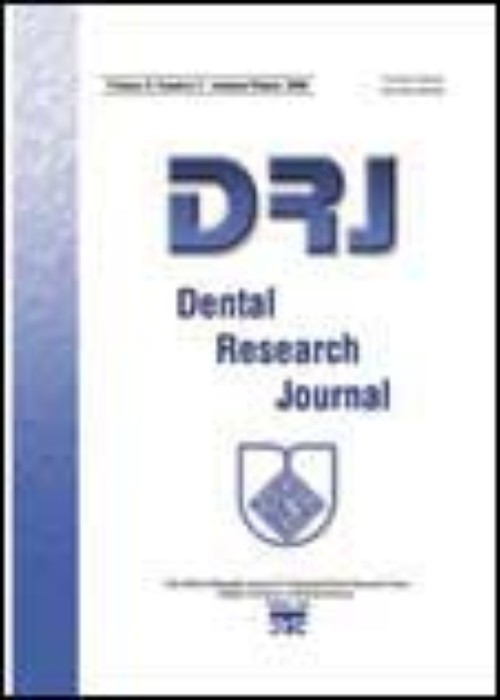In vitro effect of XP‑Endo finisher on the amount of residual debris and smear layer on the root canal walls
Author(s):
Article Type:
Research/Original Article (دارای رتبه معتبر)
Abstract:
Background
A successful endodontic treatment depends on efficient cleaning and shaping and effective irrigation of root canals. The irrigating solution may not be effective in some areas in the canal. The manufacturer of XP‑Endo finisher claims that it can effectively clean the root canals with complex morphology. This study aimed to assess the effect of XP‑Endo finisher on the amount of residual debris and smear layer on the root canal walls of mandibular second premolars.
Materials and Methods
In this In vitro study Fifty extracted mandibular second premolars with a root curvature <20° were collected. Root canals were prepared using BioRaCe rotary system. The root canals were in contact with the file and different irrigating solutions for 1 min. The teeth were then randomly divided into four experimental (n = 10) and one positive control group as follows: (1) XPF + saline, (2) XPF + ethylenediaminetetraacetic acid (EDTA), (3) XPF + sodium hypochlorite (NaOCl), (4) XPF + EDTA + NaOCl and (control) EDTA + NaOCl. The teeth were longitudinally sectioned into two halves and the amount of debris and smear layer remaining in the coronal, middle, and apical thirds of the roots was quantified and scored under an electron microscope. The Kruskal–Wallis test was used to compare the groups, and P < 0.05 was considered statistically significant.
Results
The highest mean amount of residual debris (2.9 ± 1.13) was noted in XPF + saline group (P < 0.05). XPF + saline and XPF + NaOCl (3.8 ± 0.60) had the lowest efficacy for smear layer removal (P < 0.05) with no significant within‑group difference. No significant difference was noted between Groups 2, 3, and 4 with the positive control group regarding debris removal. Groups 2 and 4 had no significant difference with the positive control group regarding smear layer removal.
Conclusion
Use of XP‑Endo finisher has no superiority to the standard protocol for the use of irrigating solutions (EDTA + NaOCl) for debris and smear layer removal, but in some cases, such as second appointment of regeneration treatment we cannot use NaOCl because of its destructive effects on stem cells; thus, we can benefit from the synergistic effects of XPF and EDTA for better smear layer removal.Keywords:
Language:
English
Published:
Dental Research Journal, Volume:16 Issue: 3, May-Jun 2019
Pages:
179 to 184
magiran.com/p1953903
دانلود و مطالعه متن این مقاله با یکی از روشهای زیر امکان پذیر است:
اشتراک شخصی
با عضویت و پرداخت آنلاین حق اشتراک یکساله به مبلغ 1,390,000ريال میتوانید 70 عنوان مطلب دانلود کنید!
اشتراک سازمانی
به کتابخانه دانشگاه یا محل کار خود پیشنهاد کنید تا اشتراک سازمانی این پایگاه را برای دسترسی نامحدود همه کاربران به متن مطالب تهیه نمایند!
توجه!
- حق عضویت دریافتی صرف حمایت از نشریات عضو و نگهداری، تکمیل و توسعه مگیران میشود.
- پرداخت حق اشتراک و دانلود مقالات اجازه بازنشر آن در سایر رسانههای چاپی و دیجیتال را به کاربر نمیدهد.
دسترسی سراسری کاربران دانشگاه پیام نور!
اعضای هیئت علمی و دانشجویان دانشگاه پیام نور در سراسر کشور، در صورت ثبت نام با ایمیل دانشگاهی، تا پایان فروردین ماه 1403 به مقالات سایت دسترسی خواهند داشت!
In order to view content subscription is required
Personal subscription
Subscribe magiran.com for 70 € euros via PayPal and download 70 articles during a year.
Organization subscription
Please contact us to subscribe your university or library for unlimited access!


